IPv6 Convergence for IoT Cyber–Physical Systems
Abstract
:1. Introduction
Cyber–Physical Systems
2. Background
- Ethernet: IEEE 802.3 is a working group and a collection of IEEE standards produced by the working group defining the physical layer and data link layer’s media access control (MAC) of wired Ethernet. Data rates range from 10 Mbps to 5GBASE-T (IEEE 802.3bz), 25 Gbps (IEEE 802.3by) and 400 Gbps (IEEE 802.3bs). This is generally a local area network technology used for core network backhaul with some wide-area network applications. Physical connections are made between nodes and/or infrastructure devices (hubs, switches, routers) by various types of copper or fiber cable.
- EIA/TIA-485 (RS-485): The RS-485 standard was developed jointly by two trade associations: the Electronic Industries Association (EIA) and the Telecommunications Industry Association (TIA). The EIA once labeled all its standards with the prefix “RS” (Recommended Standard). Many engineers continue to use this designation, but the EIA/TIA has officially replaced “RS” with “EIA/TIA” to help identify the origin of its standards. It is a differential full duplex multipoint system supporting a maximum data rate of 10 Mbps up to a distance of 4000 ft [10].
- IEEE 802.15.4: IEEE 802.15.4 is a standard created and maintained by consultants which specifies the physical layer and media access control for low-rate wireless personal area networks (LR–WPANs). It is maintained by the IEEE 802.15 working group, which has defined it in 2003 [11].
- IEEE 802.15.4g: This is an amendment to IEEE Std 802.15.4-2011, where requirements for outdoor low-data-rate, wireless and smart-metering utility network requirements are addressed.
- IEEE 802.11: IEEE 802.11 is a set of media access control (MAC) and physical layer (PHY) specifications for implementing wireless local area network (WLAN) computer communication in the 900 MHz and 2.4, 3.6, 5 and 60 GHz frequency bands.
- LTE Rel. 12+: NB-IoT: Long Term Evolution (LTE) and LTE-Advanced [12,13] are 4th generation (4G) wireless communications standards designed to support low-latency (e.g., 5 ms at the user plane and 50 ms at the control plane) and high-bandwidth requirements (e.g., 50 Mb/s–1 Gb/s) between connected devices and the core network. From Release 12 onwards, Narrow Band IoT (NB–IoT) is supported. NB–IoT is a 3GPPP cellular technology for low-data-rate and low-power wide-area IoT networking. Frequency Division Duplexing (FDD) is used and the uplink and downlink bandwidth for a single NB–IoT carrier is 180 kHz [14]. Deployment options include standalone operation, within an existing LTE band, and/or within LTE guard bands. The MAC layer transport block size (TBS) can range from 2 bytes up to 125 bytes as specified by 3GPP TS36.213 [15]. IP support is dependent on TBS size due to the larger overhead associated with IP networking [16].
- LoRaWAN: LoRaWAN is low power wide area network specification intended for wireless- battery-operated IoT devices in regional, national or global deployments [3,17]. LoRaWAN targets key requirements for secure bidirectional communication, mobility and localization services. We detail the range of data payload capabilities in Appendix A [17,18].
- SigFox: SigFox created an ultra-narrowband IoT communications system designed to support IoT deployments over long ranges, for example, in excess of 20 km between a client device and a basestation [19]. This company has adopted an operator model, essentially creating a cellular network for IoT devices. Ultra-narrow-band operation is achieved using channel bandwidths of approximately 1 kHz that transport data payloads measured in tens of bytes. SigFox has targeted licence-exempt spectrum for their product, namely the 915 MHz band in the US and 868 MHz band in Europe. SigFox’s model is a cloud-based approach where data are passed to the backend server and customer portal directly; users must then implement callbacks to route the received data to their own systems [19]. Sigfox does not support IP networking.
- RPMA: Random-phase multiple access (RPMA) is a bidirectional IoT communications technology developed by Ingenu that operates in the 2.4 GHz ISM band. Ingenu claim that RPMA coverage can extend up to 300 square miles, throughput of 19 kbps/MHz and an uplink link budget of 180 dB and 185 dB for downlink in the US. Citing security concerns, RPMA does not support IP connectivity. Instead, Ingenu choose to provide a REST API instead for data access [7].
- WEIGHTLESS: Weightless-P is a bidirectional communications technology that uses a combination of frequency-domain multiple access (FDMA) and time-domain multiple access (TDMA) operating using 12.5 kHz channel bandwidths. It was designed for use in the 169 MHz, 433 MHz, 470 MHz, 780 MHz, 868 MHz, 915 MHz and 923 MHz spectrum segments. It supports data rates from 200 bps to 100 kbps [6]. Two other variants are also available from the Weightless special interest group. Weightless-N is a unidirectional technology designed for 10-year operation using batteries with a 5 km+ range. Weightless-W was designed for 3–5 year operation using batteries but mainly targeted for use in “white space” spectrum, that is, generally described as the unused and available segments in the ultra-high-frequency band [20]. Neither of the Weightless variants support IP networking.
- MIoTy: Developed by Fraunhofer-IIS, MIoTy is a telegram-splitting multiple-access wireless technology requiring a bandwith of 200 kHz. It fragments data packets into numerous subpackets or telegrams, and distributes them over time and frequency. MIoTy was designed to support up to 15 km range in flat terrain, up to 65,000 messages per hour, 407 bits/s, have enhanced interference-resilience features for use in shared spectrum segments, for example, 868 MHz, 915 MHz ISM bands via the time- and frequency-distribution approach, and support mobility up to approximately 80 km/h [8]. MIoTy does not support IP connectivity.
- IEEE 802.11af: The IEEE 802.11af standard uses sub-1-GHz spectrum to extend broadband coverage to urban users. Unlike a cellular approach, this technology adopts a WLAN topology and was designed to use up to four bonded TV channels to achieve in excess of 400 Mbit/s data rates. This technology is better suited to neighbourhood WLAN-type deployments [21].
- IEEE 802.11ah: IEEE 802.11ah Task Group developed a new standard to address the particular requirements of M2M networks, which include a large number of power-constrained stations; a long transmission range; small and infrequent data messages; low data rates; and a non-critical delay. IEEE 802.11ah was designed to support 1 MHz and 2 MHz channels for the IoT and home automation services. However, it can increase this bandwidth to 4 MHz, 8 MHz or 16 MHz for larger data-rate requirements [22].
2.1. 5G Ecosystem Context
2.1.1. Heterogeneous Networks
2.2. The Path Towards IP Convergence
3. IP-Convergence Model
3.1. 6LoWPAN
3.1.1. Challenges
- 1-octet Dispatch
- 1-octet LOWPAN_IPHC
- 1-octet Hop Limit
- 2-octet Source Address
- 2-octet Destination Address
- How could we support at least a PDU size of 81 octets to meet the worst-case 6LoWPAN PDU size requirement?
- How can we support multi-hop networks?
- What new research was needed to address PDU size support for less than 81 octets to enable IPv6 support on highly constrained networking technologies?
3.2. LoRaWAN
3.3. IPv6 over LoRaWAN
4. Proposed Approach
4.1. Protocol Packing
4.1.1. Fragmentation Strategy
- Datagram_size: This 11-bit field encodes the size of the entire IP packet before link-layer fragmentation (but after IP-layer fragmentation).
- Datagram_tag: The value of datagram_tag (datagram tag) shall be the same for all link fragments of a payload.
- Datagram_offset: This field is present only in the second and subsequent link fragments and specifies the offset, in increments of 8 octets of the fragment from the beginning of the payload datagram.
4.2. IPv6 over LoRaWAN
- As a concept, protocol packing appears a feasible approach of encapsulating 6LoWPAN PDUs in existing US and EU LoRaWAN payloads.
- Protocol packing is potentially a method to preserve standards/alliance compliance.
- For maximum usage efficiency of the underlying communications technology, we still need to develop methods to support 6LoWPAN PDUs for the lowest LoRaWAN data rates; for example, for 19-, 59- and 61-octet payloads.
- Perform command compression and additional field eliding. Copy the 6LoWPAN PDU frame into the frame payload field of the LoRaWAN MAC payload data structure.
- Insert this MAC payload into the LoRaWAN PHY payload frame field.
- Map the PHY payload frame into the LoRaWAN radio frame.
- The LoRaWAN frame is ready for dispatch.
5. Evaluation and Results
6. Conclusions
Author Contributions
Conflicts of Interest
Abbreviations
| ACK | Acknowledgment |
| AODV | Ad-hoc on-demand distance vector |
| CPS | Cyber–physical system |
| CRC | Cyclic redundancy check |
| DSR | Dynamic source routing |
| EIA | Electronic Industries Association |
| ICMPv6 | Internet Control Message Protocol version 6 |
| IETF | Internet Engineering Task Force |
| IoT | Internet of things |
| IPv6 | Internet Protocol version 6 |
| LPWA | Low-power wide-area networking |
| MAC | Medium access control |
| M2M | Machine to machine |
| MTU | Maximum transmission unit |
| NB–IoT | Narrow-band internet of things |
| PAN | Personal area network |
| PHY | Physical layer |
| PDCP | Packet Data Convergence Protocol |
| PDU | Protocol data unit |
| RLC | Radio link control |
| RPMA | Random-phase multiple access |
| SQL | Structured Query Language |
| TIA | Telecommunications Industry Association |
| TBS | Transport block size |
| XML | eXtensible Markup Language |
| 3GPPP | 3G Public Private Partnership |
| 5GPPP | 5G Public Private Partnership |
| 6LoWPAN | IPv6 over low-power wireless personal area network |
Appendix A. Tables of LoRa Maximum Payload Sizes
| Maximum Payload Sizes (US)—Repeater Compatible | ||
|---|---|---|
| Data Rate | MAC Payload Length | MAC Control Field Length |
| 0 | 19 | 11 |
| 1 | 61 | 53 |
| 2 | 137 | 129 |
| 3 | 250 | 242 |
| 4 | 250 | 242 |
| 5:7 | Not defined | |
| 8 | 41 | 33 |
| 9 | 117 | 109 |
| 10 | 230 | 222 |
| 11 | 230 | 222 |
| 12 | 230 | 222 |
| 13 | 230 | 222 |
| 14:15 | Not defined | |
| Maximum Payload Sizes (US)—Not Repeater Compatible | ||
|---|---|---|
| Data Rate | MAC Payload Length | MAC Control Field Length |
| 0 | 19 | 11 |
| 1 | 61 | 53 |
| 2 | 137 | 129 |
| 3 | 250 | 242 |
| 4 | 250 | 242 |
| 5:7 | Not defined | |
| 8 | 61 | 53 |
| 9 | 137 | 129 |
| 10 | 250 | 242 |
| 11 | 250 | 242 |
| 12 | 250 | 242 |
| 13 | 250 | 242 |
| 14:15 | Not defined | |
| Maximum Payload Sizes (EU)—Repeater Compatible | ||
|---|---|---|
| Data Rate | MAC Payload Length | MAC Control Field Length |
| 0 | 59 | 51 |
| 1 | 59 | 51 |
| 2 | 59 | 51 |
| 3 | 123 | 115 |
| 4 | 230 | 222 |
| 5 | 230 | 222 |
| 6 | 230 | 222 |
| 7 | 230 | 222 |
| 8:15 | Not defined | |
| Maximum Payload Sizes (EU)—Not Repeater Compatible | ||
|---|---|---|
| Data Rate | MAC Payload Length | MAC Control Field Length |
| 0 | 59 | 51 |
| 1 | 59 | 51 |
| 2 | 59 | 51 |
| 3 | 123 | 115 |
| 4 | 250 | 242 |
| 5 | 250 | 242 |
| 6 | 250 | 242 |
| 7 | 250 | 242 |
| 8:15 | Not defined | |
| Maximum Payload Sizes (EU)—Repeater Compatible | ||
|---|---|---|
| Data Rate | MAC Payload Length | MAC Control Field Length |
| 3 | 123 | 115 |
| 4 | 230 | 222 |
| 5 | 230 | 222 |
| 6 | 230 | 222 |
| 7 | 230 | 222 |
| Maximum Payload Sizes (EU)—Not Repeater Compatible | ||
|---|---|---|
| Data Rate | MAC Payload Length | MAC Control Field Length |
| 3 | 123 | 115 |
| 4 | 250 | 242 |
| 5 | 250 | 242 |
| 6 | 250 | 242 |
| 7 | 250 | 242 |
| Maximum Payload Sizes (US)—Repeater Compatible | ||
|---|---|---|
| Data Rate | MAC Payload Length | MAC Control Field Length |
| 2 | 137 | 129 |
| 3 | 250 | 242 |
| 4 | 250 | 242 |
| 9 | 117 | 109 |
| 10 | 230 | 222 |
| 11 | 230 | 222 |
| 12 | 230 | 222 |
| 13 | 230 | 222 |
| Maximum Payload Sizes (US)—Not Repeater Compatible | ||
|---|---|---|
| Data Rate | MAC Payload Length | MAC Control Field Length |
| 2 | 137 | 129 |
| 3 | 250 | 242 |
| 4 | 250 | 242 |
| 9 | 137 | 129 |
| 10 | 250 | 242 |
| 11 | 250 | 242 |
| 12 | 250 | 242 |
| 13 | 250 | 242 |
References
- CPSoS Project. D2.4 Analysis of the State-of-the-Art and Future Challenges in Cyber-Physical Systems of Systems; European Union: Brussels, Belgium, 2013. [Google Scholar]
- LAN/MAN Standards Committee. ANSI/IEEE 802.15.4–2006—IEEE Standard for Information Technology— Local and Metropolitan Area Networks—Specific Requirements—Part 15.4: Wireless Medium Access Control (MAC) and Physical Layer (PHY) Specifications for Low Rate Wireless Personal Area Networks (WPANs); IEEE Standards Association: New York, NY, USA, 2006; Volume 2006, p. 323. [Google Scholar]
- LoRa Alliance. LoRa-Alliance|LoRaWAN for Developers. Available online: https://www.lora-alliance.org/lorawan-for-developers (accessed on 26 March 2018).
- Sigfox. Sigfox Technology Overview; Sigfox: Labège, France, 2016. [Google Scholar]
- Huawei. NB-IOT White Paper; Huawei: Shenzhen, China, 2015. [Google Scholar]
- Webb, W. Weightless: A Bespoke Technology for the IoT; Technical Report; Weightless: Cambridge, UK, 2013; Available online: http://www.weightless.org/news/weightless-a-bespoke-technology-for-the-iot (accessed on 26 March 2018).
- Ingenu. How RPMA Works: The Making of RPMA; Ingenu: San Diego, CA, USA, 2016; p. 92. [Google Scholar]
- Fraunhofer IIS. MIOTY—The Wireless IoT Platform; Fraunhofer IIS: Munich, Germany, 2018; Available online: http://mioty.de/ (accessed on 26 March 2018).
- Nolan, K.E.; Guibene, W.; Kelly, M.Y. An evaluation of low power wide area network technologies for the Internet of Things. In Proceedings of the 2016 International Wireless Communications and Mobile Computing Conference (IWCMC), Paphos, Cyprus, 5–9 September 2016; pp. 439–444. [Google Scholar]
- Maxim Integrated Products. RS-485 (EIA/TIA-485) Differential Data Transmission System Basics—Tutorial; Maxim Integrated Products: San Jose, CA, USA, 2001. [Google Scholar]
- IEEE Standards Association (IEEE SA). IEEE Standard for Local and Metropolitan Area Networks—Part 15.4: Low-Rate Wireless Personal Area Networks (LR-WPANs) Amendment 3: Physical Layer (PHY) Specifications for Low-Data-Rate, Wireless, Smart Metering Utility Networks; IEEE SA—802.15.4g-2012; IEEE SA: Piscataway, NJ, USA, 2012. [Google Scholar]
- Ghosh, A.; Ratasuk, R. Essentials of LTE and LTE-A; Cambridge University Press: Cambridge, UK, 2011; pp. 1–249. [Google Scholar]
- Parkvall, S.; Dahlman, E.; Furuskär, A.; Jading, Y.; Olsson, M.; Wänstedt, S.; Zangi, K. LTE-Advanced—Evolving LTE towards IMT-Advanced. In Proceedings of the IEEE Vehicular Technology Conference, Calgary, BC, Canada, 21–24 September 2008. [Google Scholar]
- Beyene, Y.D.; Jantti, R.; Ruttik, K.; Iraji, S. On the performance of narrow-band internet of things (NB–IoT). In Proceedings of the IEEE Wireless Communications and Networking Conference (WCNC), San Francisco, CA, USA, 19–22 March 2017. [Google Scholar]
- Teesside Small Gauge Railway. TS 136 213—V13.0.0—LTE: Evolved Universal Terrestrial Radio Access (E-UTRA); Physical Layer Procedures (3GPP TS 36.213 Version 13.0.0 Release 13); Teesside Small Gauge Railway: Stockton-on-Tees, UK, 2016. [Google Scholar]
- GSMA. 3GPP Low Power Wide Area Technologies (LPWA); GSMA White Paper; GSMA: London, UK, 2016; p. 19. [Google Scholar]
- Semtech. SX1272 Long Range; Low Power RF Transceiver 860–1000 MHz with LoRa® Technology; Semtech: Camarillo, CA, USA; Available online: https://www.semtech.com/products/wireless-rf/lora-transceivers/SX1272 (accessed on 26 March 2018).
- Semtech. LoRa Family|Wireless and RF ICs for ISM Band Applications; Semtech: Camarillo, CA, USA; Available online: https://www.semtech.com/products/wireless-rf/lora-gateways (accessed on 26 March 2018).
- SigFox. About SIGFOX; SigFox: Labège, France, 2018; Available online: https://www.sigfox.com/en.
- Weightless Management Ltd. Weightless-P Standard Is Designed for High Performance, Low Power, 2-Way Communication for IoT; Weightless Management Ltd.: Cambridge, UK, 2015; Available online: http://www.weightless.org/news (accessed on 26 March 2018).
- IEEE Standards Association. IEEE Std 802.11af–2013 (Amendment to IEEE Std 802.11-2012, as Amended by IEEE Std 802.11ae-2012, IEEE Std 802.11aa-2012, IEEE Std 802.11ad-2012, and IEEE Std 802.11ac-2013)—IEEE Standard for Information Technology—Telecommunications and Information Exchange between Systems—Local and Metropolitan Area Networks—Specific Requirements—Part 11: Wireless LAN Medium Access Control (MAC) and Physical Layer (PHY) Specifications Amendment 5: Television White Spaces (TVWS) Operation; IEEE Standards Association: Piscataway, NJ, USA, 2014. [Google Scholar]
- Adame, T.; Bel, A.; Bellalta, B.; Barcelo, J.; Oliver, M. IEEE 802.11ah: The Wi-Fi Approach for M2M Communications. IEEE Wirel. Commun. 2014, 21, 144–152. [Google Scholar] [CrossRef]
- 5G PPP Architecture Working Group. View on 5G Architecture View on 5G Architecture, 2016. 5G PPP Architecture Working Group. Available online: https://5g-ppp.eu/wp-content/uploads/2014/02/5G-PPP-5G-Architecture-WP-July-2016.pdf (accessed on 26 March 2018).
- Mobile Europe. Verizon Outlines First 5G Radio Specification, 2016. Mobile Europe. Available online: https://www.mobileeurope.co.uk/press-wire/verizon-outlines-first-5g-radio-specification (accessed on 26 March 2018).
- Verizon 5G Technical Forum. Available online: http://www.5gtf.net (accessed on 26 March 2018).
- Ericsson, C. Verizon 5G TF; Network and Signalling Working Group; Verizon 5 th Generation Radio Access; 5G Packet Data Convergence Protocol (5G-PDCP) Specification (Release 1) Document Approvals Name Title Company Date of Approval; Verizon: New York, NY, USA, 2016. [Google Scholar]
- Chávez-Santiago, R.; Szydełko, M.; Kliks, A.; Foukalas, F.; Haddad, Y.; Nolan, K.E.; Kelly, M.Y.; Masonta, M.T.; Balasingham, I. 5G: The Convergence of Wireless Communications. Wirel. Personal Commun. 2015, 83, 1617–1642. [Google Scholar] [CrossRef] [PubMed]
- Korhonen, J. 3GPP ‘5G’ Mobility Considerations, 2016. Available online: https://datatracker.ietf.org/meeting/95/materials/slides-95-dmm-0/ (accessed on 26 March 2018).
- Chakrabarti, S.; Mishra, A. QoS issues in ad hoc wireless networks. IEEE Commun. Mag. 2001, 39, 142–148. [Google Scholar] [CrossRef]
- Park, S.; Savvides, A.; Srivastava, M. Simulating networks of wireless sensors. In Proceedings of the 33nd Conference on Winter simulation, Arlington, VA, USA, 9–12 December 2001; pp. 1330–1338. [Google Scholar]
- Aberer, K.; Hauswirth, M.; Salehi, A. Infrastructure for data processing in large-scale interconnected sensor networks. In Proceedings of the 2007 International Conference on Mobile Data Management, Mannheim, Germany, 7–11 May 2007; pp. 198–205. [Google Scholar]
- Akribopoulos, O.; Georgitzikis, V.; Protopapa, A.; Chatzigiannakis, I. Building a platform-agnostic wireless network of interconnected smart objects. In Proceedings of the 15th Panhellenic Conference on Informatics, Kastoria, Greece, 30 September–2 October 2011; pp. 277–281. [Google Scholar]
- Thielemans, S.; Bezunartea, M.; Steenhaut, K. Establishing transparent IPv6 communication on LoRa based low power wide area networks (LPWANS). In Proceedings of the Wireless Telecommunications Symposium, Chicago, IL, USA, 26–28 April 2017. [Google Scholar]
- Weber, P.; Jäckle, D.; Rahusen, D.; Sikora, A. IPv6 over LoRaWAN™. In Proceedings of the 2016 IEEE 3rd International Symposium on Wireless Systems within the IEEE International Conferences on Intelligent Data Acquisition and Advanced Computing Systems, Manipal, India, 13–16 September 2017; pp. 75–79. [Google Scholar]
- Schumacher, C.P.P.; Kushalnagar, N.; Montenegro, G. IPv6 over Low-Power Wireless Personal Area Networks (6LoWPANs): Overview, Assumptions, Problem Statement, and Goals; IETF: Fremont, CA, USA, 2015. [Google Scholar]
- White, G. Active queue management in DOCSIS® 3.1 networks. IEEE Commun. Mag. 2015, 53, 126–132. [Google Scholar] [CrossRef]
- Ronan, J.; Walsh, K.; Long, D. Evaluation of a DTN convergence layer for the AX.25 network protocol. In Proceedings of the Second International Workshop on Mobile Opportunistic Networking (MobiOpp ’10), Pisa, Italy, 22–23 February 2010; p. 72. [Google Scholar]
- Taylor, D.E.; Herkersdorf, A.; Döring, A.; Dittmann, G. Robust header compression (ROHC) in next-generation network processors. IEEE/ACM Trans. Netw. 2005, 13, 755–768. [Google Scholar] [CrossRef]
- Conta, A.; Gupta, M. Internet Control Message Protocol (ICMPv6) for the Internet Protocol Version 6 (IPv6) Specification; IETF: Fremont, CA, USA, 2017. [Google Scholar]
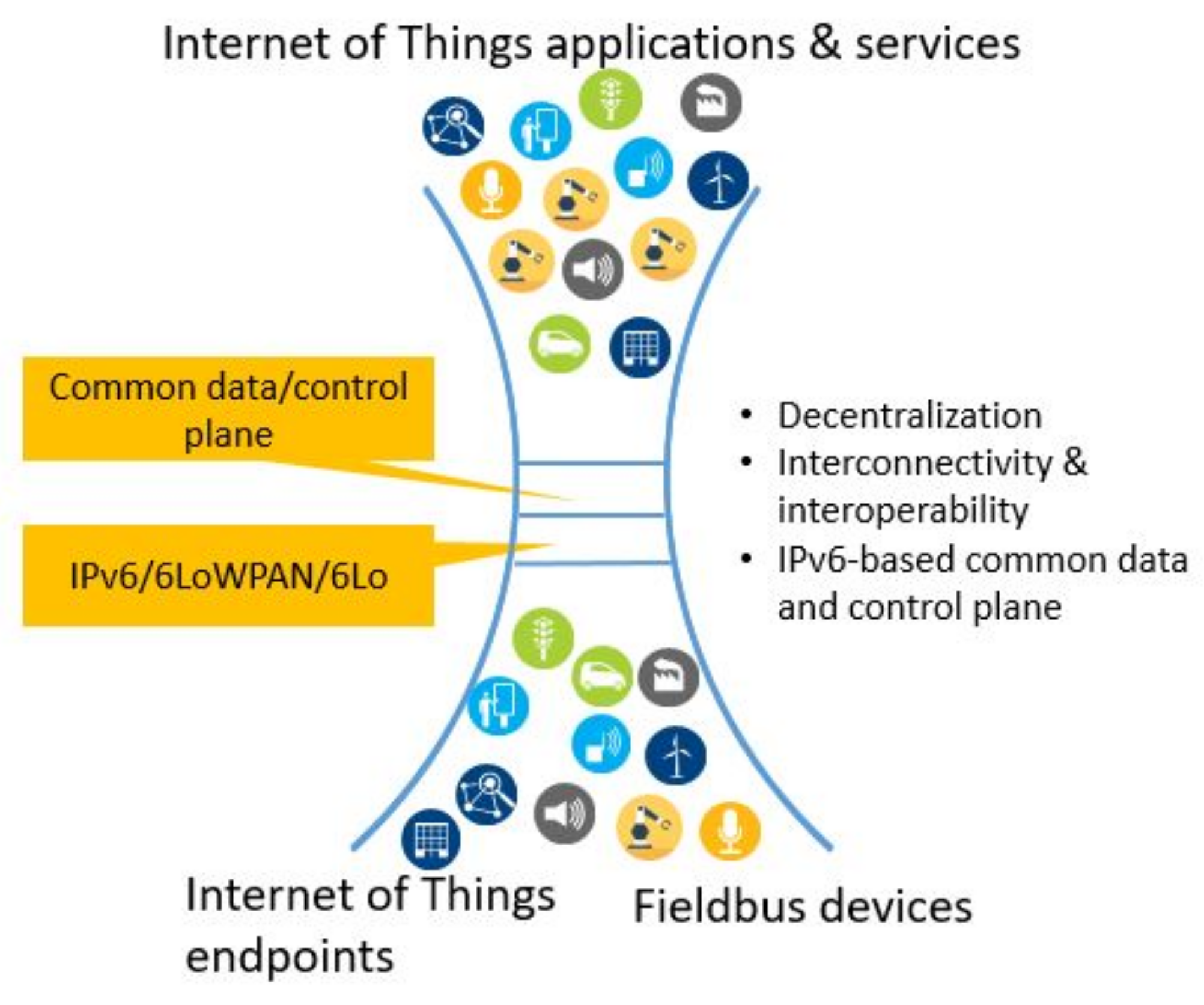
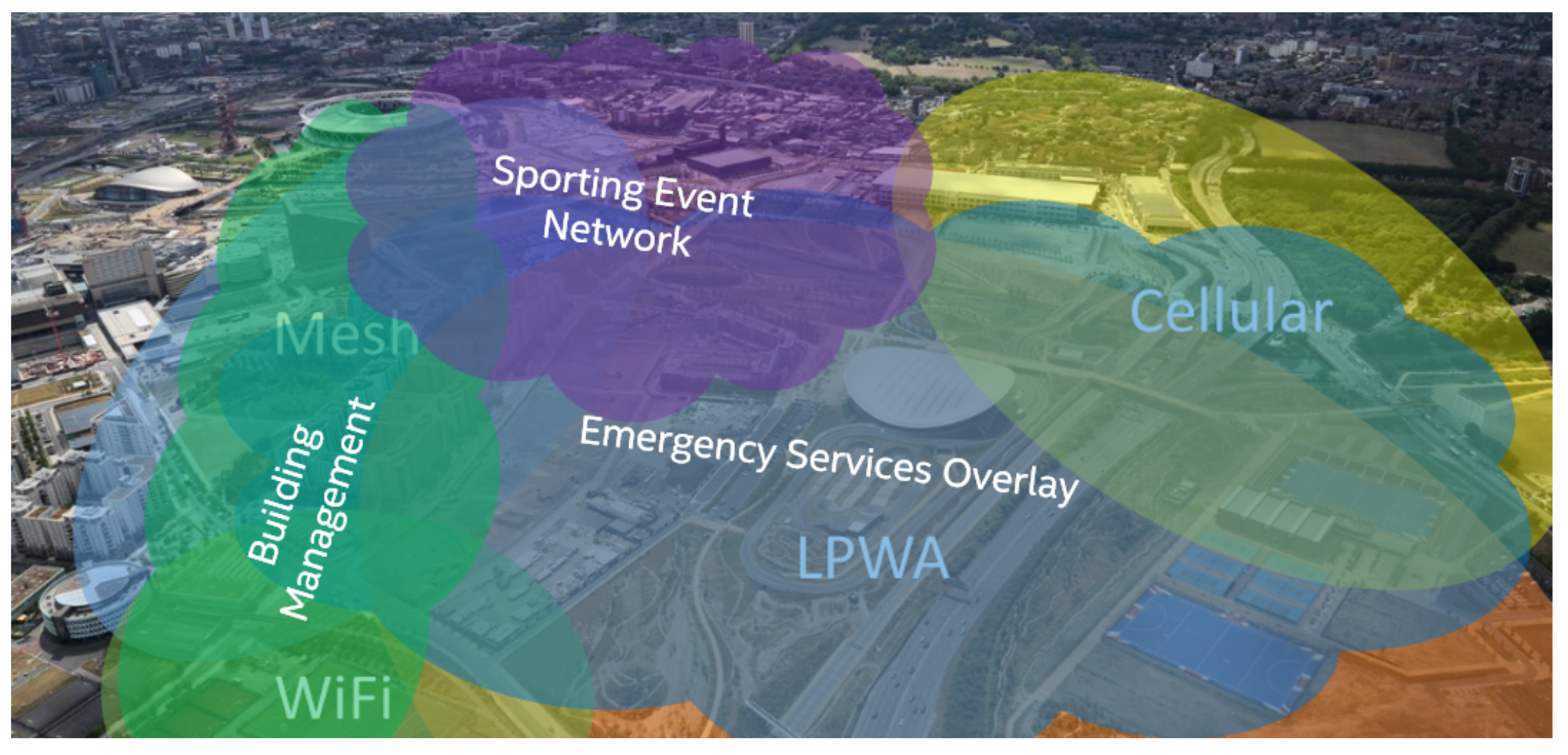

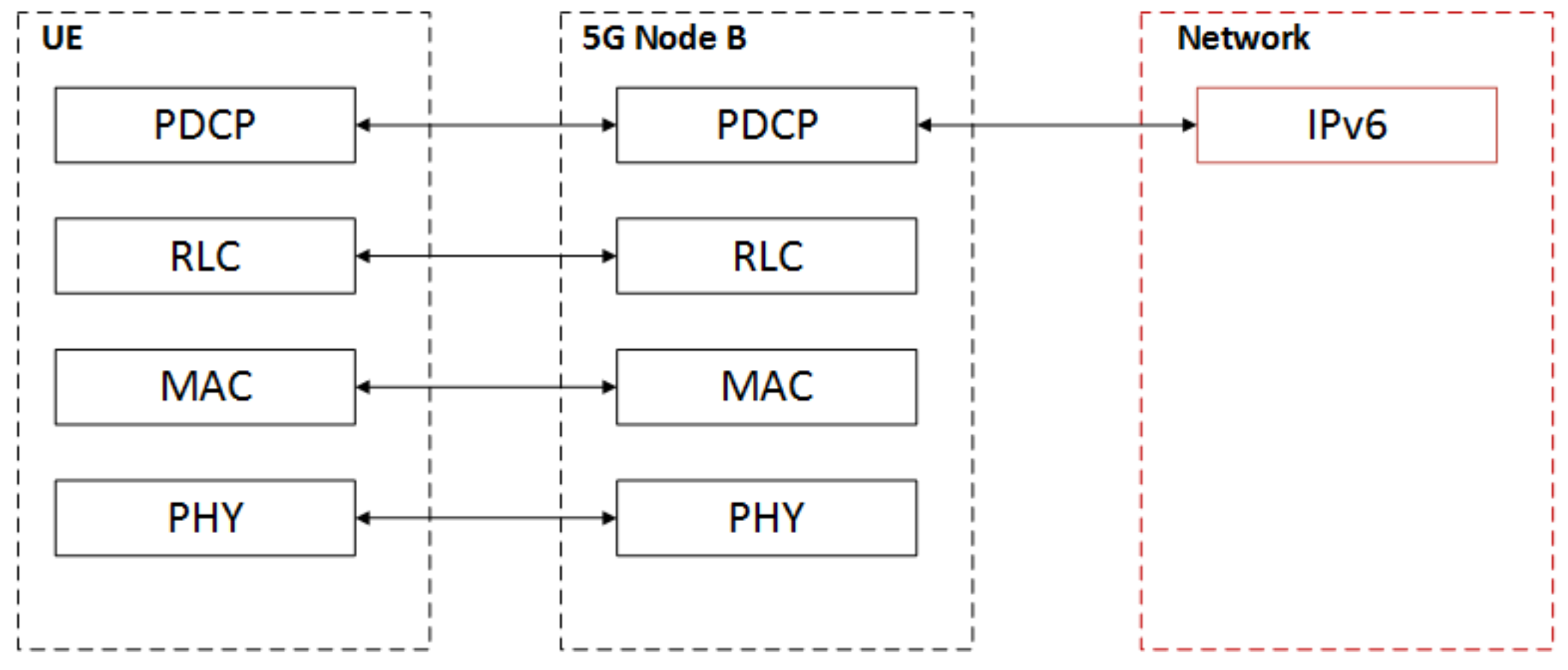









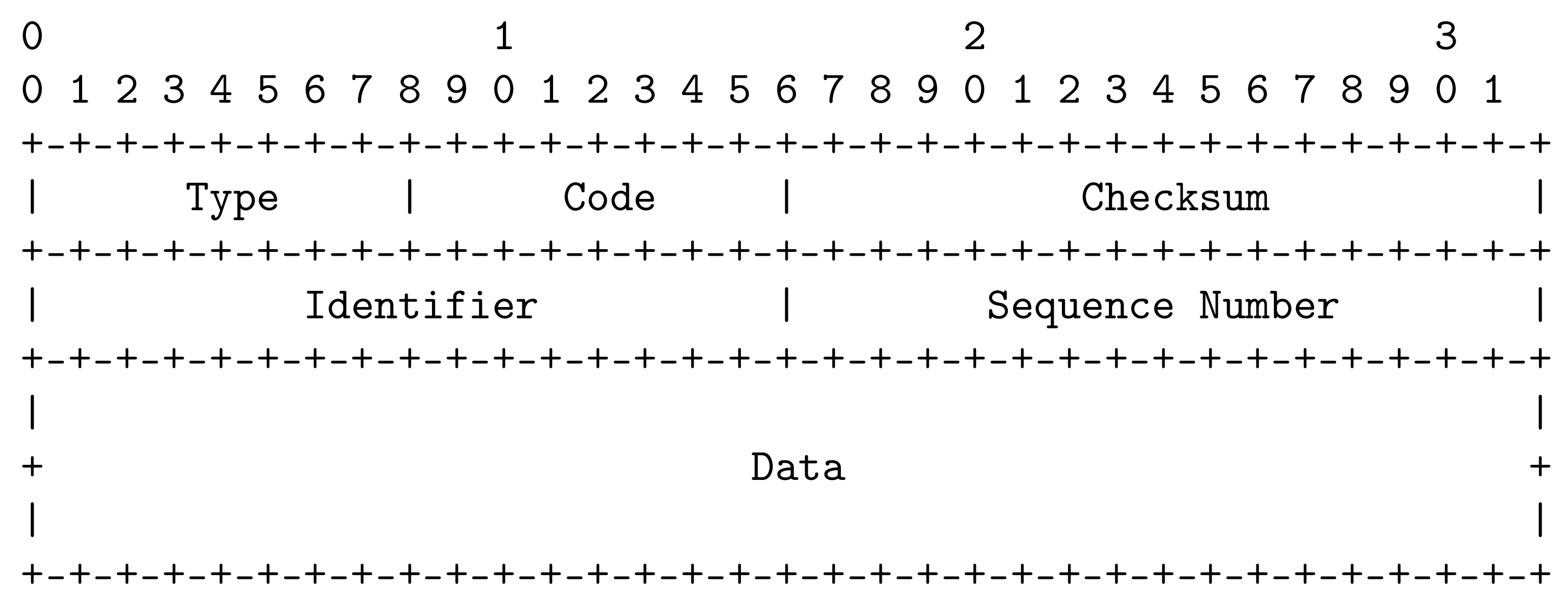


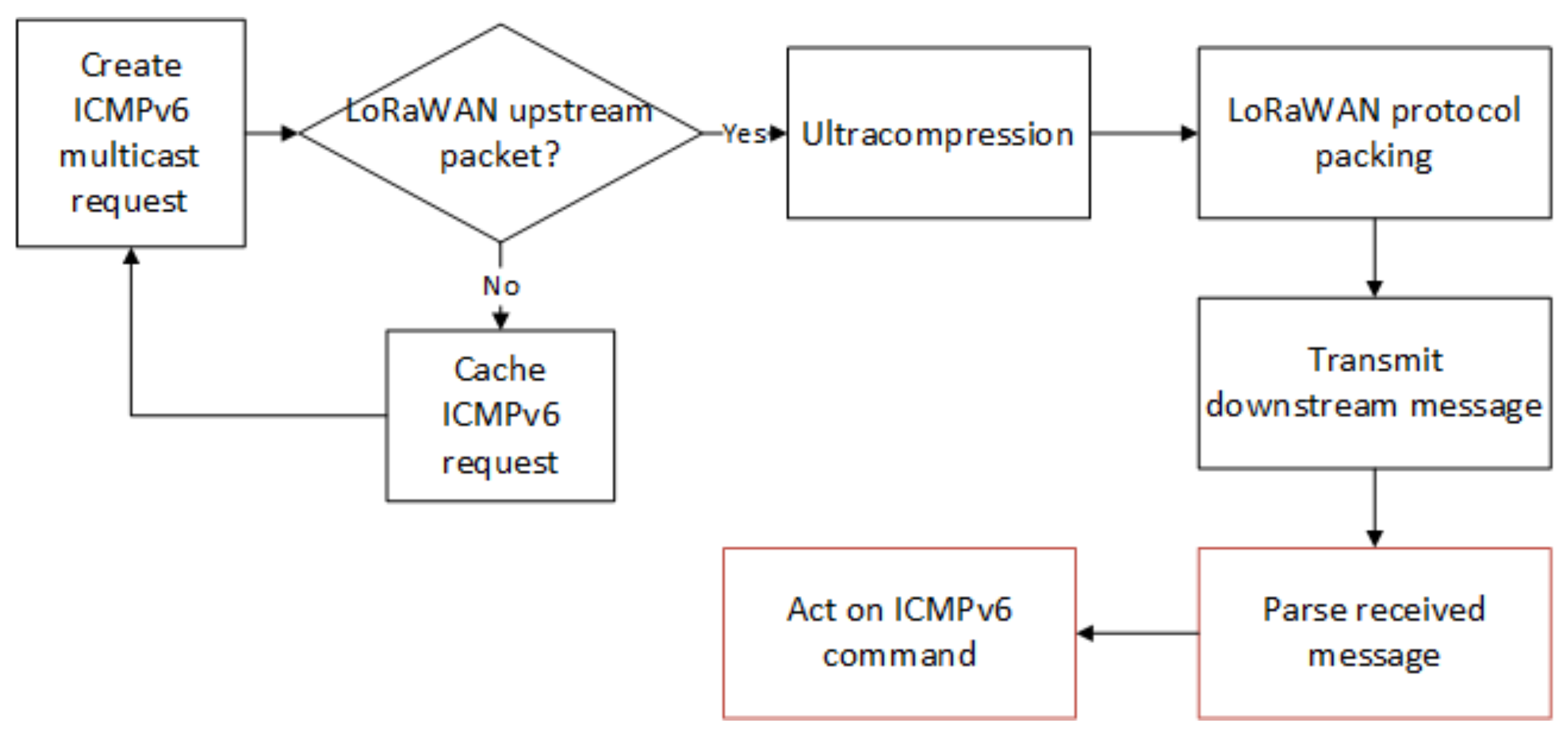



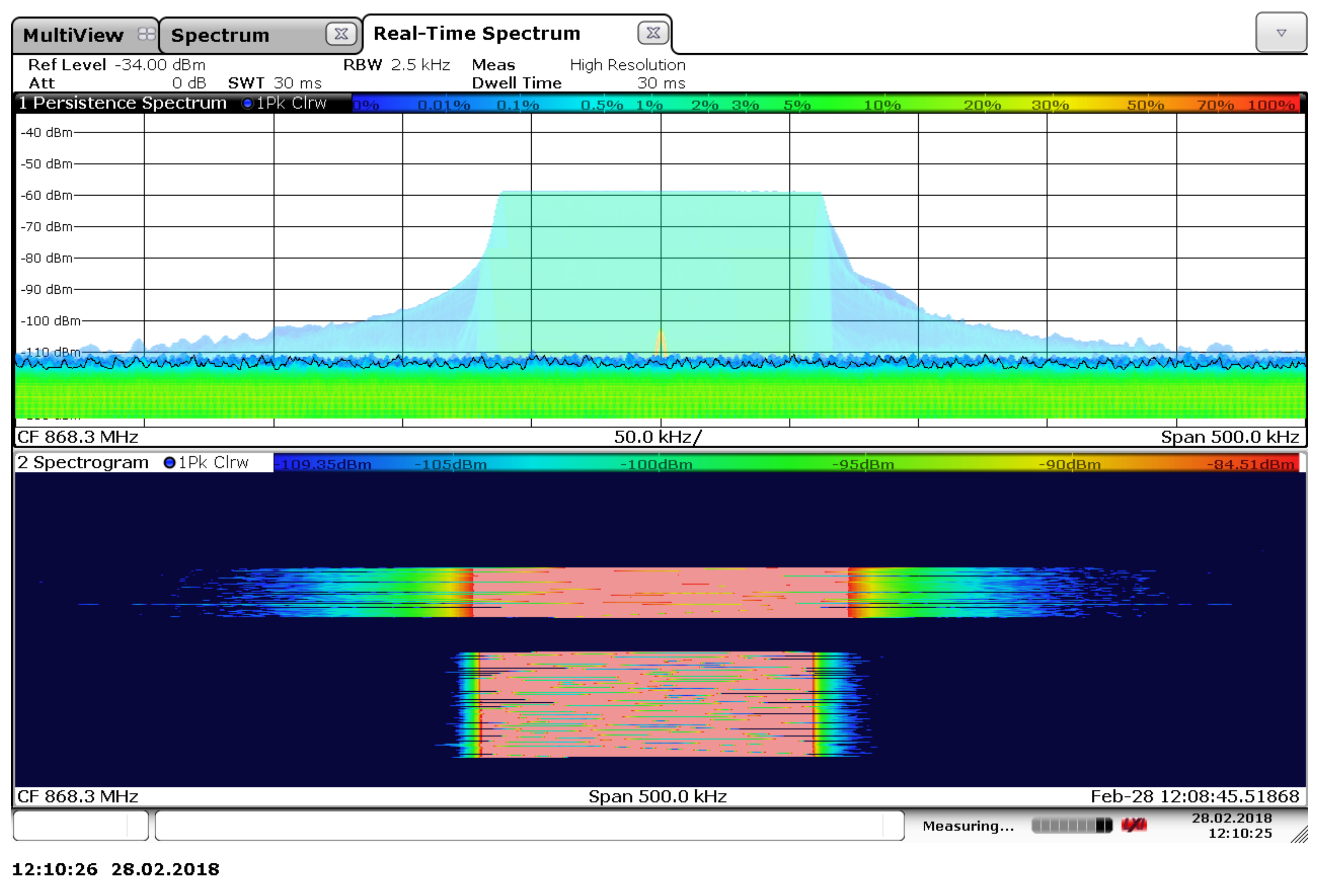
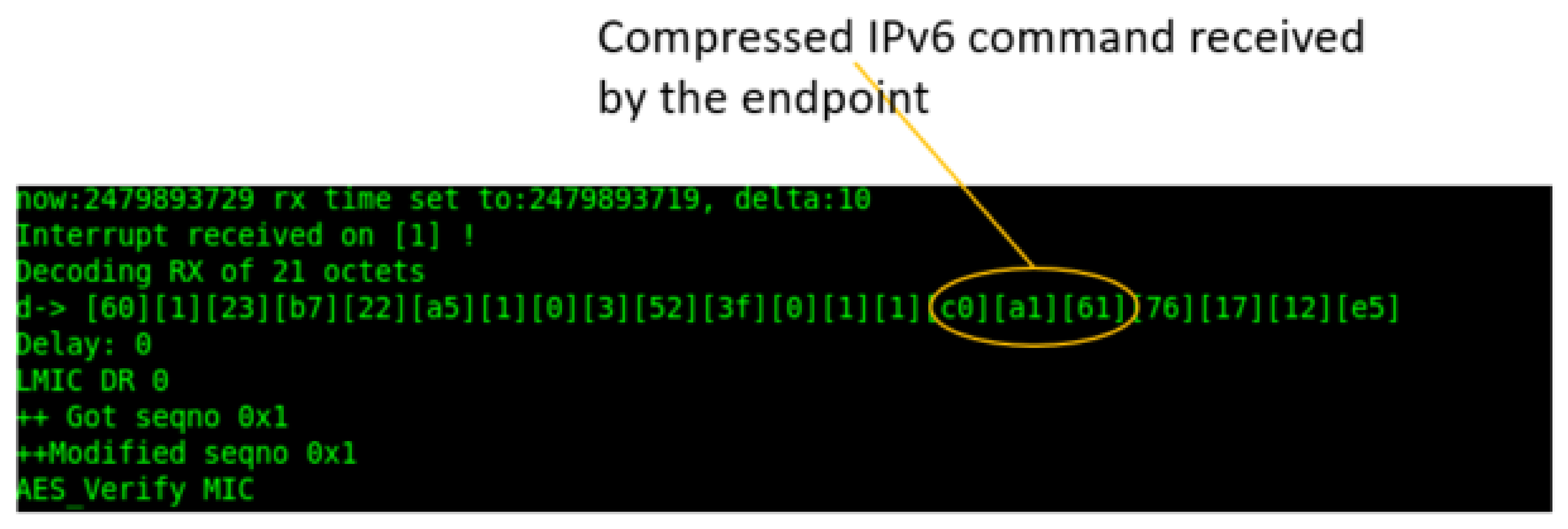
| IP | Non-IP |
|---|---|
| IEEE 802.3 (Ethernet) | TIA/RS-485 |
| IEEE 802.11 af/ah | IEEE 802.15.4 (without 6LoWPAN) |
| IEEE 802.15.4g | LoRAWAN |
| LTE Rel 12+/NB–IoT (transport block size dependent) | RPMA |
| SigFox | |
| MIoTy |
| Scheme | Packet Size (bytes) | Compression Factor |
|---|---|---|
| IPv6 worst-case PDU | 81 | |
| Proposed approach | 3 | 27 |
© 2018 by the authors. Licensee MDPI, Basel, Switzerland. This article is an open access article distributed under the terms and conditions of the Creative Commons Attribution (CC BY) license (http://creativecommons.org/licenses/by/4.0/).
Share and Cite
Nolan, K.; Kelly, M. IPv6 Convergence for IoT Cyber–Physical Systems. Information 2018, 9, 70. https://doi.org/10.3390/info9040070
Nolan K, Kelly M. IPv6 Convergence for IoT Cyber–Physical Systems. Information. 2018; 9(4):70. https://doi.org/10.3390/info9040070
Chicago/Turabian StyleNolan, Keith, and Mark Kelly. 2018. "IPv6 Convergence for IoT Cyber–Physical Systems" Information 9, no. 4: 70. https://doi.org/10.3390/info9040070





